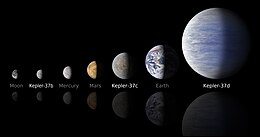
Kepler-37, also known as UGA-1785, is a G-type main-sequence star located in the constellation Lyra 209 light years from Earth. It is host to exoplanets Kepler-37b, Kepler-37c, Kepler-37d and Kepler-37e, all of which orbit very close to it. Kepler-37 has a mass about 80.3 percent of the Sun's and a radius about 77 percent as large. It has a temperature similar to that of the Sun, but a bit cooler at 5,417 K. It has about half the metallicity of our Sun. With an age of roughly 6 billion years, it is slightly older than the Sun, but is still a main-sequence star. Until January 2015, Kepler-37 was the smallest star to be measured via asteroseismology.
Kepler-37b is the closest planet to the Kepler-37. At the time of its discovery in February 2013, it was the smallest known exoplanet. At 3,865 kilometres (2,402 mi) in diameter, it is slightly larger than the Moon. It orbits Kepler-37 once every 13 days at a distance of about 0.1 astronomical units (AU). Kepler-37b has a rocky surface and is believed to be too small and too close to its star to support water or maintain an atmosphere. Surface temperature is estimated at 700 K (427 °C; 800 °F).
Kepler-37c is around three-quarters of the diameter of Earth and orbits approximately every 21 days at a distance of just under 0.14 AU. Kepler-37d is about twice the diameter of Earth. It orbits in around 40 days at a distance of nearly 0.21 AU. Neither is able to support water due to their proximity to Kepler-37.
The periods of the three inner planets are close (within one per cent) to a 5:8:15 mean-motion resonance relationship.
Distance: 208.9 to 0.4 ly
Planets: 3 Exoplanets (earthlike) and 1 unknown
Binary: No
